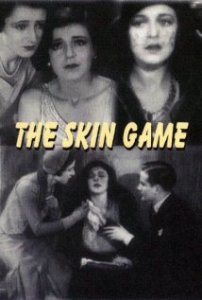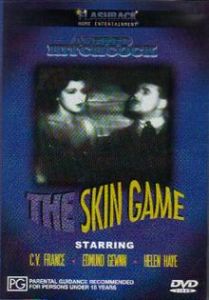The Skin Game ** (1931, Edmund Gwenn, Jill Esmond, C V France, Helen Haye) – Classic Movie Review 2101
Produced by British International Pictures, The Skin Game (1931) is worth a little look but it is a mostly fairly tedious experience, and one of Alfred Hitchcock’s least interesting movies, probably just of interest for Hitchcock completists only.
The Master has difficulty summoning up sympathy in and involvement with his faded source material in John Galsworthy’s stage play about a fervent clash in an English village between an old-money, upper class family called the Hillcrists (C V France and Helen Haye as Mr and Mrs Hillcrist and Jill Esmond as their daughter Jill) and an upstart speculator called Hornblower (Edmund Gwenn) and his family (John Longden, Phyllis Konstam and Frank Lawton). The rival families’ ensuing feud has disastrous results.
In an unlikely turns of events, Haye’s Mrs Hillcrist finds Hornblower’s daughter Chloe (Phyllis Konstam) is a prostitute and blackmails Hornblower into stopping his lucrative schemes to buy up land, evict tenant farmers and fill the area with factories.
Even with a screenplay by Hitch himself and additional dialogue by his wife Alma Reville, the socially-conscious, improbable screenplay isn’t up to much at all, though there is an attempt to develop Galsworthy’s themes of class warfare and the urbanisation of the countryside. The film is also hampered by generally stagey performances and visually uncinematic treatment by a clearly uninspired director evidently held back by the early sound cameras, which tend to sink it.
The exception, acting-wise, is the ingratiating performance of one of Hitch’s favourite actors, Edmund Gwenn, who is the film’s main saving grace and holds some interest as the nouveau riche Mr Hornblower. Gwenn reappeared twice for the director, cast against type as a villain in Foreign Correspondent, and in The Trouble with Harry.
So, it is worth a quick look for Hitchcock box set owners maybe (Alfred Hitchcock the Collection) but it is evidence that, away from thrillers, Hitch was much less powerful. Hitchcock said: ‘I didn’t make it by choice, and there isn’t much to be said about it. We shot with four cameras and a single soundtrack because we couldn’t cut sound in those days.’
The movie marks the film debut aged 23 of English actress Jill Esmond (26 January 1908 – 28 July 1990), the first wife of Laurence Olivier.
The film was thought to be in the public domain for decades, but its rights were obtained by French media company Canal+ in 2005. A restored and remastered print of the film was released on DVD by Lionsgate Home Entertainment in 2007.
An English Heritage blue plaque, unveiled in 1999, marks where Sir Alfred Hitchcock lived in London at 153 Cromwell Road, Kensington and Chelsea, SW5.
© Derek Winnert 2015 Classic Movie Review 2101
Check out more reviews on http://derekwinnert.com/







